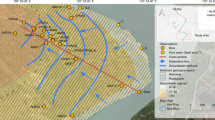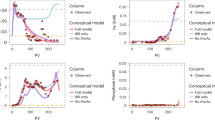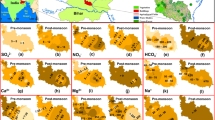Abstract
The consumption of shallow groundwater with elevated concentrations of arsenic is causing widespread disease in many parts of South and Southeast Asia. In the Bengal Basin, a growing reliance on groundwater sourced below 150-m depth—where arsenic concentrations tend to be lower—has reduced exposure. Groundwater flow simulations have suggested that these deep waters are at risk of contamination due to replenishment with high-arsenic groundwater from above, even when deep water pumping is restricted to domestic use. However, these simulations have neglected the influence of sediment adsorption on arsenic migration. Here, we inject arsenic-bearing groundwater into a deep aquifer zone in Bangladesh, and monitor the reduction in arsenic levels over time following stepwise withdrawal of the water. Arsenic concentrations in the injected water declined by 70% after 24 h in the deep aquifer zone, owing to adsorption on sediments; concentrations of a co-injected inert tracer remain unchanged. We incorporate the experimentally determined adsorption properties of sands in the deep aquifer zone into a groundwater flow and transport model covering the Bengal Basin. Simulations using present and future scenarios of water-use suggest that arsenic adsorption significantly retards transport, thereby extending the area over which deep groundwater can be used with low risk of arsenic contamination. Risks are considerably lower when deep water is pumped for domestic use alone. Some areas remain vulnerable to arsenic intrusion, however, and we suggest that these be prioritized for monitoring.
This is a preview of subscription content, access via your institution
Access options
Subscribe to this journal
Receive 12 print issues and online access
$259.00 per year
only $21.58 per issue
Buy this article
- Purchase on Springer Link
- Instant access to full article PDF
Prices may be subject to local taxes which are calculated during checkout




Similar content being viewed by others
References
Ravenscroft, P., Brammer, H. & Richards, K. Arsenic Pollution: A Global Synthesis (Wiley-Blackwell, 2009).
BGS/DPHE (British Geological Survey, Dept. of Public Health Engineering). Arsenic Contamination of Groundwater in Bangladesh, Final Report (British Geological Survey, 2001).
BBS/UNICEF (Bangladesh Bureau of Statistics/United Nations Children’s Fund) Bangladesh National Drinking Water Quality Survey of 2009 (UNICEF, 2011).
Fendorf, S., Michael, H. A. & van Geen, A. Spatial and temporal variations of groundwater arsenic in south and southeast Asia. Science 328, 1123–1127 (2010).
Ahmed, M. F. et al. Epidemiology: Ensuring safe drinking water in Bangladesh. Science 314, 1687–1688 (2006).
DPHE/JICA (Dept. of Public Health Engineering, Bangladesh, Japan International Cooperation Agency) Report on Situation Analysis of Arsenic Mitigation, 2009 (Local Government Division, Government of Bangladesh, DPHE, JICA, 2010).
van Geen, A. et al. Monitoring 51 community wells in Araihazar, Bangladesh, for up to 5 years: Implications for arsenic mitigation. J. Environ. Sci. Health A 42, 1729–1740 (2007).
Brammer, H. & Ravenscroft, P. Arsenic in groundwater: A threat to sustainable agriculture in South and South-east Asia. Environ. Int. 35, 647–654 (2009).
Zheng, Y. et al. Geochemical and hydrogeological contrasts between shallow and deeper aquifers in two villages of Araihazar, Bangladesh: Implications for deeper aquifers as drinking water sources. Geochim. Cosmochim. Acta 69, 5203–5218 (2005).
Burgess, W. G. et al. Vulnerability of deep groundwater in the Bengal Aquifer System to contamination by arsenic. Nature Geosci. 3, 83–87 (2010).
Chakraborti, D. et al. Status of groundwater arsenic contamination in the state of West Bengal, India: A 20-year study report. Mol. Nutr. Food Res. 53, 542–551 (2009).
Mukherjee, A. et al. Elevated arsenic in deeper groundwater of the western Bengal basin, India: Extent and controls from regional to local scale. Appl. Geochem. 26, 600–613 (2011).
Michael, H. A. & Voss, C. I. Evaluation of the sustainability of deep groundwater as an arsenic-safe resource in the Bengal Basin. Proc. Natl Acad. Sci. USA 105, 8531–8536 (2008).
Dixit, S. & Hering, J. G. Comparison of arsenic(V) and arsenic(III) sorption onto iron oxide minerals: Implications for arsenic mobility. Environ. Sci. Technol. 37, 4182–4189 (2003).
Jonsson, J. & Sherman, D. M. Sorption of As(III) and As(V) to siderite, green rust (fougerite) and magnetite: Implications for arsenic release in anoxic groundwaters. Chem. Geol. 255, 173–181 (2008).
Smedley, P. L. & Kinniburgh, D. G. A review of the source, behaviour and distribution of arsenic in natural waters. Appl. Geochem. 17, 517–568 (2002).
Stollenwerk, K. G. et al. Arsenic attenuation by oxidized aquifer sediments in Bangladesh. Sci. Total Environ. 379, 133–150 (2007).
Radloff, K. A. et al. Mobilization of arsenic during one-year incubations of grey aquifer sands from Araihazar, Bangladesh. Environ. Sci. Technol. 41, 3639–3645 (2007).
Fuller, C. C., Davis, J. A. & Waychunas, G. A. Surface-chemistry of Ferrihydrite. 2. Kinetics of arsenate adsorption and coprecipitation. Geochim. Cosmochim. Acta 57, 2271–2282 (1993).
Raven, K. P., Jain, A. & Loeppert, R. H. Arsenite and arsenate adsorption on ferrihydrite: Kinetics, equilibrium, and adsorption envelopes. Environ. Sci. Technol. 32, 344–349 (1998).
Selim, H. M. & Zhang, H. Arsenic adsorption in soils: Second-order and multireaction models. Soil Sci. 172, 444–458 (2007).
Schroth, M. H., Istok, J. D. & Haggerty, R. In situ evaluation of solute retardation using single-well push–pull tests. Adv. Water Resour. 24, 105–117 (2001).
Cassiani, G., Burbery, L. F. & Giustiniani, M. A note on in situ estimates of sorption using push–pull tests. Wat. Resour. Res. 41, W03005 (2005).
Haggerty, R. & Gorelick, S. M. Multiple-rate mass-transfer for modeling diffusion and surface-reactions in media with pore-scale heterogeneity. Wat. Resour. Res. 31, 2383–2400 (1995).
Wood, W. W., Kraemer, T. F. & Hearn, P. P. Intragranular diffusion—an important mechanism influencing solute transport in clastic aquifers. Science 247, 1569–1572 (1990).
Dhar, R. K et al. Microbes enhance mobility of arsenic in Pleistocene aquifer sand from Bangladesh. Environ. Sci. Technol. 45, 2648–2654 (2011).
McArthur, J. M. et al. Migration of As, and 3H/3He ages, in groundwater from West Bengal: Implications for monitoring. Wat. Res. 44, 4171–4185 (2010).
Goodbred, S. L., Kuehl, S. A., Steckler, M. S. & Sarker, M. H. Controls on facies distribution and stratigraphic preservation in the Ganges–Brahmaputra delta sequence. Sedim. Geol. 155, 301–316 (2003).
Jung, H. B., Charette, M. A. & Zheng, Y. Field, laboratory, and modeling study of reactive transport of groundwater arsenic in a coastal aquifer. Environ. Sci. Technol. 43, 5333–5338 (2009).
van Geen, A. et al. Flushing history as a hydrogeological control on the regional distribution of arsenic in shallow groundwater of the Bengal Basin. Environ. Sci. Technol. 42, 2283–2288 (2008).
Harvey, C. F. et al. Arsenic mobility and groundwater extraction in Bangladesh. Science 298, 1602–1606 (2002).
Polya, D. & Charlet, L. Environmental science: Rising arsenic risk? Nature Geosci. 2, 383–384 (2009).
Michael, H. A. & Voss, C. I. Controls on groundwater flow in the Bengal Basin of India and Bangladesh: Regional modeling analysis. Hydrogeol. J. 17, 1561–1577 (2009).
Michael, H. A. & Voss, C. I. Estimation of regional-scale groundwater flow properties in the Bengal Basin of India and Bangladesh. Hydrogeol. J. 17, 1329–1346 (2009).
Harbaugh, A. W., Banta, E. R., Hill, M. C. & McDonald, M. G. MODFLOW-2000, the US Geological Survey Modular Ground-Water Model—User Guide to Modularization Concepts and the Ground-Water Flow Process US Geological Survey Open-File Report 00–92 (US Department of the Interior, US Geological Survey, 2000).
Zheng, C. & Wang, P. P. MT3DMS: A Modular Three-Dimensional Multispecies Model for Simulation of Advection, Dispersion and Chemical Reactions of Contaminants in Groundwater Systems; Documentation and User’s Guide. (US Army Engineer Research and Development Center, 1999).
Gleick, P. H. et al. The World’s Water: 2008–2009 (Island Press, 2009).
von Bromssen, M. et al. Targeting low-arsenic aquifers in Matlab Upazila, Southeastern Bangladesh. Sci. Total Environ. 379, 121–132 (2007).
Gelhar, L. W., Welty, C. & Rehfeldt, K. R. A critical review of data on field-scale dispersion in aquifers. Wat. Resour. Res. 28, 1955–1974 (1992).
Neuman, S. P. Universal scaling of hydraulic conductivities and dispersivities in geologic media. Wat. Resour. Res. 26, 1749–1758 (1990).
Acknowledgements
Columbia University and the University of Dhaka’s research in Araihazar has been supported since 2000 by NIEHS Superfund Basic Research Program grant NIEHS 5 P42 ES010349. Undergraduate student support was received from Barnard College and the Earth Institute at Columbia University. The authors thank L. Konikow and C. Voss (US Geological Survey) for modelling advice and H. C. Siu for the grain size analysis (Bronx Science High School). This is Lamont-Doherty Earth Observatory contribution number 7496.
Author information
Authors and Affiliations
Contributions
K.A.R., Y.Z., M.S., K.M.A. and A.v.G. designed the adsorption studies. K.A.R., M.S., I.M. and Y.Z. conducted the push–pull experiments. Y.Z. conducted the batch adsorption experiments. H.M. designed and executed the hydrological model of the Bengal Basin. I.M., M.B., M.R.H., I.C., M.W.R. provided field and laboratory assistance for the adsorption experiments. B.C.B. provided sediment mineralogical analysis. P.S. advised and supported the work of K.A.R. K.A.R, Y.Z., and H.M. analysed the data and wrote the paper, which was then edited by A.v.G.
Corresponding author
Ethics declarations
Competing interests
The authors declare no competing financial interests.
Supplementary information
Supplementary Information
Supplementary Information (PDF 2183 kb)
Rights and permissions
About this article
Cite this article
Radloff, K., Zheng, Y., Michael, H. et al. Arsenic migration to deep groundwater in Bangladesh influenced by adsorption and water demand. Nature Geosci 4, 793–798 (2011). https://doi.org/10.1038/ngeo1283
Received:
Accepted:
Published:
Issue Date:
DOI: https://doi.org/10.1038/ngeo1283
This article is cited by
-
Biogeochemical properties and potential risk of shallow arsenic-rich sediment layers to groundwater quality in Western Bangladesh
Environmental Geochemistry and Health (2022)
-
Assessment of potential health risk of major contaminants of groundwater in a densely populated agricultural area
Environmental Geochemistry and Health (2021)
-
Modelling heavy metals contamination in groundwater of Southern Punjab, Pakistan
International Journal of Environmental Science and Technology (2021)
-
Arsenic contamination of Bangladesh aquifers exacerbated by clay layers
Nature Communications (2020)
-
Impact of sedimentation history for As distribution in Late Pleistocene-Holocene sediments in the Hetao Basin, China
Journal of Soils and Sediments (2020)



